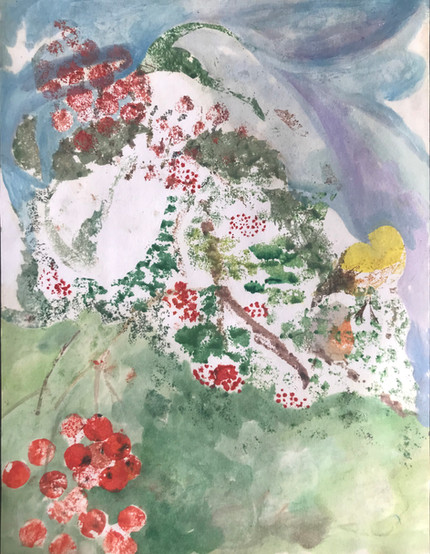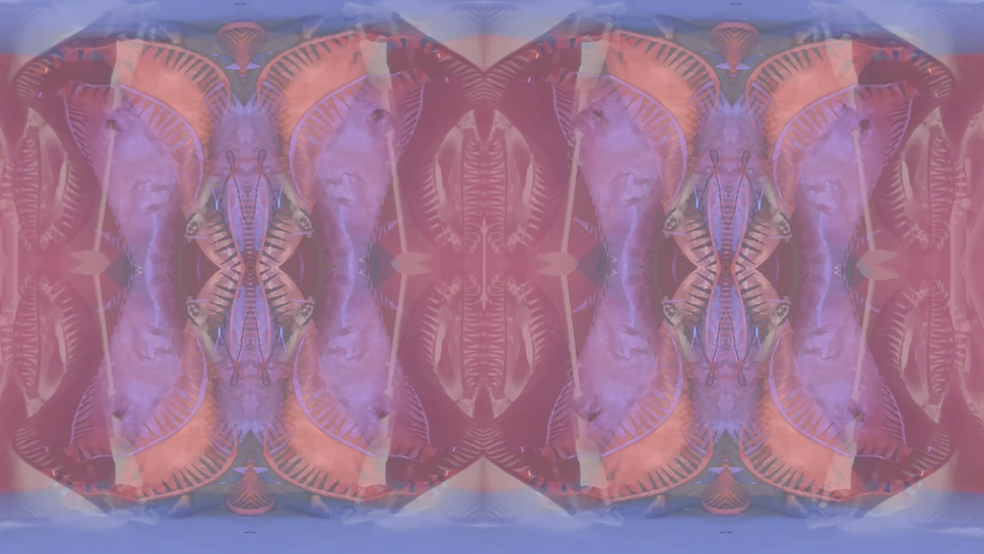Intérieures, 03.03.22 - 03.04.22
- Cache Studio

- Apr 12, 2022
- 4 min read

Artists Curator
Mathilde Bois Stephanie Cambria Pardiss Amerian Catherine Boisvenue Ménard
Eve Saint Jean
Mathilde Bois
Artist and researcher Mathilde Bois lives and works in Quebec City. Her practice in drawing, watercolor, and painting is fuelled by a fascination for the materiality of images and the fragility of the self. Associate artist of the choreographic work Les dix commandements by Harold Rhéaume, she has more recently developed an interest in the representation of the body and the forces that run through it. Her work has been presented in group and solo exhibitions in Quebec and Europe, including the Women's Museum in Bonn.
In parallel to her artistic practice, Mathilde Bois is an art critic, curator, and researcher in phenomenology. After studying art history and philosophy, she completed a master's degree in 2020 on the perception of images in Husserl. She is now pursuing her research in phenomenology on the question of image and corporeality as a scientific collaborator at the Institut für Transzendentalphilosophie und Phenomenologie in Wuppertal (Germany). Winner in 2018 of the Young Critics competition of the magazine Esse, she has also published several texts and essays on contemporary art for Quebec magazines and cultural institutions, including, most recently, the essay Les imagiers de la matière, for the eponymous exhibition she curated.
Pardiss Amerian
Pardiss Amerian is a visual artist currently based in Montreal, where she is completing her Master's in Fine Arts at Concordia University. Her practice is a process-based exploration of painting and collage driven by narrative asides, as a way to address temporality, transhistoricity, and the lyric potential of an imagined elsewhere. Amerian holds an MFA from Concordia University and a BFA from OCAD University. Recent exhibitions include Jack Hanley Gallery (New York), Zalucky Contemporary (Toronto, ON), and Gallery PFOAC (Montreal, QC). Her work has been supported by the Tom Hopkins Memorial Award and can be found in public and private collections in Canada and The United States.
Eve Saint Jean
Originally from Mont Tremblant, Eve Saint Jean lives and works in Montreal (QC). After completing a DEC in Visual Arts at Cégep Lionel-Groulx, she explored various university programs, such as the Bachelor of Architecture at UdeM and the Bachelor of Environmental Design at UQÀM. The artist also completed a certificate in Art History at UdeM. With the diversified knowledge she acquired when studying these disciplines, she chose to pursue her career as a self-taught visual artist, which allowed her to integrate what she learned into heterogeneous artistic visions.
Since 2017, Eve has had the opportunity to present several solo exhibitions, most notably at the AVE Gallery (Emerging Visual Arts), at the Letter Bet, and more recently at the Maison de la Culture Notre-Dame-de-Grâce. She has also participated in various group exhibitions at Marc Gosselin Gallery, Archive Contemporary Gallery in Montreal, and some group shows in New York curated by Slow Burn NYC. Finally, in 2018, she won the TELUS grant as part of the Festival Soir.
Catherine Boisvenue Ménard
Catherine completed a Master's degree in painting at Concordia University in 2021 and a Bachelor's degree in visual arts at the Université du Québec à Montréal in 2016. Committed to the renewal of contemporary disciplines in visual art, she uses an interdisciplinary approach. Her work generates creative and protesting forces by creating bridges between pictorial, material, spatial, bodily, and digital practices. Through painting and video performance, she triggers a reflection on the relationship to the body, the living, women, and the invisible. Working at the intersection of sculptural installation and puppet theater, she develops a kinetic universe in which the movement of her body operates diverse mutations in the imaginary space. Introducing temporalities that escape reality, she questions the boundaries of the body, its gender, and fluidity. She then weaves invisible links with her paintings through the notions of ritual, nature, fertility, and femininity. Her painting is characterized by large immersive abstractions in which repetitive gestures are animated by a performative and liberating dimension. By accumulating diverse, colorful patterns and symbols, her paintings communicate abundant lively energy, a celebratory force, and resilient power.
Intérieures
As my starting point, I took the definition of interior, a word that kept coming to mind when I thought about the works of the women in this exhibition.
In the Littré dictionary, the first definition of the word interior refers to the physical interior; literally, that is to say, the viscera, muscles, and other tissues that lie beneath the skin. I could not help but think of Mathilde Bois' Blood Venus. She pours herself entirely, physically and spiritually, into these representations of primitive Venuses by introducing a brutal content: menstrual, vascular, and placental blood.
Another definition refers to the spiritual experience, to a person's inner self. Catherine Boisvenue-Ménard transports us straight into hers through her large paintings and videos, kaleidoscopic visions of fecund camouflages: A festive and militant feminism hiding in a rich decorative universe.
The same definition of the word interior applies to the work of Eve Saint Jean, who explores another part of the soul: the vast interior of the collective unconscious. On this ground, the intimate meets the intersubjective. Her odysseys in art history deconstruct on their way overbearing archetypes that weigh down the journey.
One of the entries in the lexicon speaks of interior provinces. Pardis Amerian's work, product of a patient alchemy, plunges us into the depths of intimate regions, an amalgam of the magic of Iranian miniatures and the secrets of familiar vines and flora.
As Lacan once said, "the woman does not exist." The practices of these women incorporate probabilities that shatter the monolithic conception of woman from within; they are probable because they are born from the core, because they are interior.
- Stephanie Cambria










































Comments